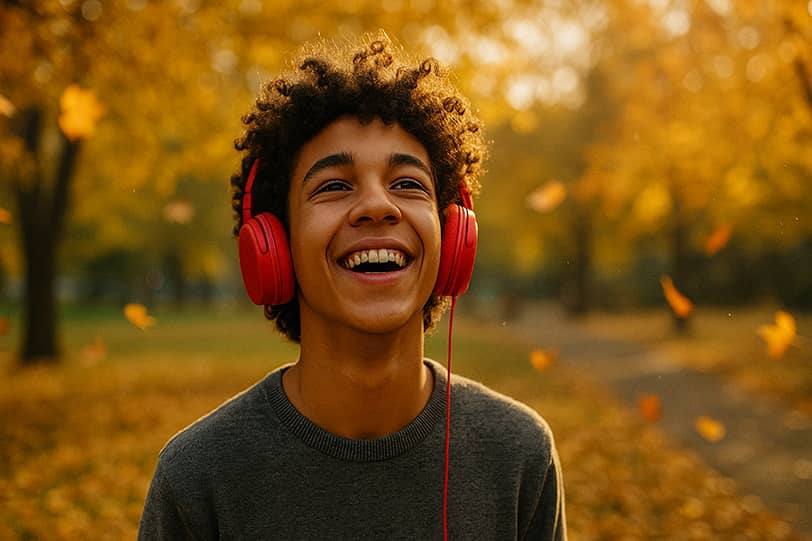Headphones have long ceased to be just an accessory for listening to music—they have become an integral part of daily life, a kind of “sonic extension” of one’s personality. We wear them on the subway, during a run, at the office, and even at home, creating our own audio space in a noisy world.
For some, it’s a way to focus; for others, it’s a means to block out external distractions; and for some, it’s a ritual without which they can’t get into the right mindset. But have you ever thought that your choice of headphones might not be accidental? What if your preferences in models, volume, and even music genres reveal far more than it seems at first glance?
Here’s a tricky question: can you determine a person’s character by their headphones? It turns out, the connection between technology and psychology runs much deeper than we’re used to thinking. The type of headset, duration of use, volume, and even how a person handles the wires (neatly coils them or hopelessly tangles them)—all of this can serve as a kind of personality marker. Some choose massive studio headphones, emphasizing a serious attitude toward sound, while others never part with compact earbuds, valuing mobility and minimalism. Some listen to music at maximum volume, as if trying to drown out the outside world, while others prefer a barely audible background to stay connected to reality.
The goal of this article is to understand how our sound habits reflect our inner world. We’ll examine what your headphone type says about you, why certain music genres resonate with you more than others, and how the way you use your headset reveals your psychological traits.

Headphone Type: What Does Your Choice Say About You?
Headphones are not just a device for sound reproduction—they are a kind of extension of our personality. The models we choose can say a lot about our habits, character, and even lifestyle. Some value freedom of movement and opt for wireless models, others prefer the tried-and-true classic wired headphones, while some surround themselves with professional studio monitors, as if creating their own musical universe.
Why do we subconsciously gravitate toward certain types of headsets? Psychologists claim that our choice often reflects not only practical needs but also deep psychological attitudes—from a desire for independence to a need to shut out the outside world. Let’s explore what personality traits might be behind your headphone choice.
Wireless (TWS, On-Ear) – Convenience, Mobility, a Thirst for Freedom, or Tech Dependence?
If you prefer wireless headphones, chances are you value freedom and hate unnecessary restrictions. You want nothing to hinder your movement—whether it’s a run, a subway ride, or working at a computer. You might easily adapt to new technologies and love gadgets that make life simpler.
But there’s another side: constant use of wireless headphones may indicate a slight dependence on technology. If you feel anxious leaving them at home or automatically put them in your ears even when not listening to music—this could be a sign that your headset has become a “shield” against the outside world.
Wired – Conservatism, Attention to Sound Quality, Nostalgia, or Practicality?
Those who still use wired headphones often have rational reasons. Maybe you appreciate uncompressed audio quality, which Bluetooth codecs sometimes compromise. Or you simply don’t want to rely on battery life. But there’s also a psychological aspect: your choice may indicate conservatism, a commitment to tradition, or even nostalgia for “simpler” times when technology didn’t so obviously dictate our lives.
Interestingly, some wired headphone users subconsciously associate them with reliability—after all, there’s no risk of them dying at the worst moment. This could reflect your general approach to life: you prefer tried-and-true solutions and dislike unnecessary risks.
Over-Ear – A Love for Immersive Sound, Introversion, or a Professional Approach to Music?
Large over-ear headphones are the choice of those who take sound seriously. If you use such models, you might be an audiophile, musician, or simply someone for whom music is not just background noise but an important part of life. You value deep bass, crisp highs, and love feeling completely enveloped by sound.
But there’s also a psychological component: over-ear headphones create an isolating effect, and they’re often chosen by introverts who need to feel like they’re in a “cocoon.” If you wear them even at home, it might indicate a need for personal space. On the other hand, open-back models (which let in external sounds) are often picked by those who want to stay connected to the world—like gamers or sound engineers.
In-Ear – Minimalism, an Active Lifestyle, or a Dislike for Bulky Devices?
Compact in-ear headphones are favored by those who value practicality and mobility. You’re likely active, always on the move, and dislike extra weight in your pockets. You might be a minimalist who prefers things to take up as little space as possible.
Interestingly, some in-ear users subconsciously perceive them as “invisible”—unlike bulkier models, they don’t draw attention. This could mean you don’t like standing out or prefer to blend into a crowd.
Open-Back vs. Closed-Back – Extroverts Who Don’t Mind Sound Leakage, or Introverts Creating Personal Space?
Open-back headphones (which partially let in outside sounds) are often chosen by sociable people who don’t want to completely disconnect from their surroundings. Maybe you work in an office and want to hear your colleagues, or you simply dislike feeling like you’re in a “vacuum.”
Closed-back models, on the contrary, create full isolation. They’re often preferred by introverts who value the ability to retreat into themselves. If you choose such headphones, you might be noise-sensitive and need a clear separation between “your” space and the outside world.
Thus, the type of headphones you use may not just be a matter of convenience but a real psychological marker. Take a closer look at your headset—it might reveal more about you than you think.

Volume and Usage Time: How Do We Manage Our State?
Headphones have long ceased to be just a device for listening to music—they have become a powerful tool for managing our psychological state. How loudly and how often we use them can reveal a lot about our deep-seated needs and ways of interacting with the world. Some people hardly ever take their headphones out, creating a constant soundtrack for their lives, while others use them in strict doses—only in specific situations. Some crank the volume to the max, while others prefer barely audible sound. Behind all these habits lie interesting psychological patterns.
Why do we use headphones so differently? Psychologists note that through our sound habits, we often compensate for certain emotional needs—the need for safety, control over our environment, emotional release, or, conversely, peace. Let’s take a closer look at what your habits regarding volume and headphone usage might mean.
Constant Headphone Use – Need for Background Noise, Protection from the Outside World
If you hardly ever take your headphones out during the day, it could indicate a few things. First, you might be using music or podcasts to create a comfortable sound backdrop that helps you focus or, conversely, relax. Many people with anxiety disorders or high sensitivity to external stimuli use headphones as a kind of “shield” against the chaotic noise of the outside world.
Second, constant headphone use might be a sign that you subconsciously seek to fill inner silence. For some, being alone with their thoughts can be uncomfortable, and music or other sounds become a way to avoid this state. This is especially common among city dwellers accustomed to constant audio accompaniment.
However, it’s important to remember that excessive headphone use (especially for many hours straight) can lead to increased fatigue and even contribute to social isolation. If you catch yourself using headphones even when you could do without them, it might be worth asking—have they become a way to avoid real interaction?
Only in Transit/While Running – Practical Use, Separating Personal and Public Space
If you use headphones only in specific situations—like on public transport, during a run, or in noisy public spaces—it suggests a rational approach. You clearly distinguish where you need an audio “buffer” between yourself and the outside world and where you can do without it. Such people usually have a good sense of boundaries between personal and public space.
This behavior pattern is typical for those who:
- Value conscious content consumption (listening to what they actually want, not just “background noise”).
- Maintain a balance between technology and real communication.
- Use headphones as a tool, not a permanent extension of themselves.
Interestingly, such users often carefully select what they listen to in each situation—for example, upbeat music for running, podcasts for the commute, etc.
Maximum Volume – A Desire to Escape Reality or Emotional Release?
The habit of listening to music at maximum volume can have several psychological explanations. On one hand, it might be a way to fully “immerse” yourself in the music, disconnecting from the outside world. People who feel stressed in their environment (like in a noisy office or crowded transport) often do this to create a “sound refuge.”
On the other hand, loud music can be a form of emotional release. Some psychologists note that people who suppress emotions in daily life might use loud music to “let off steam” and process strong feelings through sound.
However, it’s important to remember the risks to hearing. If you regularly listen to music at high volume, ask yourself—are you trying to drown out not external noise but some internal turmoil?
Quiet Sound – Caution, Noise Sensitivity, Conscious Content Consumption
If you prefer listening to music or podcasts at minimal volume, it might reflect certain personality traits. First, you might simply be very sensitive to loud sounds and prefer not to overload your nervous system. Such people often have high sensory sensitivity.
Second, a preference for quiet sound might reflect your conscious approach to content consumption. You don’t want to “blast” yourself with information, preferring to dose it and truly engage with what you’re hearing. This is typical of thoughtful, reflective people.
Additionally, this habit might stem from concern for your health—you’re aware of hearing risks and take care to preserve it. This suggests a rational, balanced approach to technology in general.
Interestingly, some people deliberately keep the volume low to stay aware of their surroundings—this is especially common among parents of young children or those who need to remain reachable for work.

Musical Preferences and Psychological Profile
The music we choose for our headphones is not just background noise for daily activities—it’s a true mirror of our personality. Psychologists have long established a deep connection between musical preferences and character traits. The melodies that fill your playlist can reveal your temperament, ways of processing emotions, and even your life values.
Interestingly, we often intuitively choose music that resonates with our current emotional state. During stressful periods, we might crave certain genres, while moments of joy call for completely different ones. At the same time, our stable musical preferences form a kind of “sound self-portrait” that remains relatively constant throughout life. Let’s explore what your favorite genres might say about you.
Pop, Hip-Hop, Electronic – Extroversion, Love of Rhythm, Social Activity
If your playlist is filled with energetic pop hits, catchy hip-hop beats, or fiery electronic music, you’re likely sociable and open to new experiences. Fans of these genres usually:
- Have high social activity—they enjoy being at the center of events and making new connections.
- Adapt easily to change and love variety.
- Often have a good sense of rhythm and love moving to music.
- Prefer clear, structured melodies without excessive complexity.
Psychologists note that this type of music is especially popular among extroverts, as its rhythmic and accessible nature helps maintain social bonds. Interestingly, many fans of these genres use music as a way to regulate their mood—upbeat tracks help them stay energized and active throughout the day.
Rock, Metal – Emotional Depth, Rebellious Spirit, Need for Catharsis
Fans of rock and metal often stand out for their strong individuality and depth of feeling. Their musical preferences may indicate:
- Strong emotionality—such people often experience emotions intensely.
- Independent thinking and a tendency to question societal norms.
- A need for emotional release—heavy music helps them let off steam.
- A love for complex, layered compositions with deep meaning.
Interestingly, many studies show that, contrary to stereotypes, lovers of heavy music often have high emotional intelligence. What attracts them to these genres isn’t aggression but the opportunity to experience catharsis—a powerful emotional cleansing through music. Such people usually value sincerity and depth in art and life.
Classical, Jazz, Ambient – Analytical Mind, Creativity, Reflective Nature
If you prefer intricate classical pieces, improvisational jazz, or atmospheric ambient, it may suggest:
- An analytical mind—the ability to perceive complex musical structures.
- Developed creativity and a love for unconventional solutions.
- A deep tendency for self-analysis and reflection.
- High sensitivity to sonic nuances and subtleties.
Such people often don’t use music as background noise but as an object for deep engagement. Many note that complex genres help them focus, stimulate thinking, or, conversely, allow them to fully relax. This points to a rich inner world and an ability for fine emotional tuning.
Podcasts and Audiobooks – Curiosity, Self-Improvement, Multitasking
If you listen to educational podcasts or audiobooks more often than music, it suggests:
- A constant thirst for new knowledge and self-development.
- The ability to use time efficiently (e.g., combining listening with other tasks).
- An analytical approach to information consumption.
- Often—high productivity and organizational skills.
Such people usually value practical benefits from listening and prefer their “sound space” to be filled not just with pleasant but also useful content. Interestingly, many note that audio content helps them structure their thoughts and generate new ideas.
White Noise/Nature Sounds – Anxiety, Need for Relaxation, Sleep Issues
A preference for white noise, nature sounds, or meditative compositions may indicate:
- Increased sensitivity to the environment.
- A need to control auditory space.
- Possible difficulties with relaxation and falling asleep.
- High levels of everyday stress.
Such people often use these sounds to create a predictable and safe sonic environment, especially when regular music feels too intrusive. Many report that steady ocean or rain sounds genuinely help them calm down and focus, pointing to well-developed self-regulation mechanisms.

Headphones as a Social Signal
In the modern world, headphones have become a nonverbal means of communication—a kind of social code we use daily. They long ago ceased to be just a device for listening to music—today, they’re a powerful tool for regulating social interactions. We put them on and take them off not just based on acoustic needs but also to send specific signals to those around us.
Interestingly, different cultures have developed their own unwritten rules of “headphone etiquette.” In some offices, wearing headphones means “do not disturb,” while in others, it’s perceived as antisocial behavior. Sharing music can be a bonding ritual or a demonstration of shared tastes.
“Do Not Disturb” – How Headphones Replace Verbal Boundaries
In modern society, headphones serve as a kind of “social barrier.” When we put them on, we’re essentially telling others: “I’m busy right now, don’t bother me.” This is especially important in three situations:
- In public spaces (subways, cafés) – headphones help create personal space where it physically doesn’t exist.
- In office environments – they signal to colleagues that focus is needed.
- In situations where directly saying “don’t interrupt” would be impolite.
Psychologists note that people who regularly use headphones as a “do not disturb” signal often:
- Value personal boundaries.
- Have a high need for concentration.
- May struggle with directly setting boundaries.
Interestingly, many coworking spaces and modern offices have developed entire nonverbal headphone signaling systems:
- Headphones on both ears – “I’m very busy.”
- One earbud in – “You can approach me for urgent matters.”
- Headphones around the neck – “I’m available to talk.”
Open-Back vs. Closed-Back Headphones in the Office – Availability or Focus?
The choice of headphone type in a work environment is a subtle social signal that colleagues easily pick up on:
Closed-back headphones (over-ear, noise-canceling)
- Clear signal: “I’m in deep focus mode.”
- Often used for intensive work.
- Can be perceived as unwillingness to engage in office socializing.
- In some teams, require special agreements (“when I have closed-back headphones on, don’t approach”).
Open-back headphones (letting in external sound)
- Message: “I’m available for quick questions.”
- Allow staying aware of office dynamics.
- Often used by those who value team interaction.
Wireless earbuds (one in ear)
- The most socially open option.
- Signals availability for communication.
- Popular among managers and those who need to stay reachable.
Research shows that in companies with healthy psychological climates, employees intuitively choose headphone types that match both the immediate work situation and corporate culture.
Shared Listening – Trust, Intimacy, Common Interests
Sharing headphones is a special social ritual that reveals much about relationships:
1. Romantic relationships – couples often create shared playlists or listen together via a splitter. This is:
- An act of trust (letting someone peek into your musical preferences).
- A way to sync emotional states.
- A modern equivalent of “hanging out by the tape recorder.”
2. Friendships – sharing headphones or song recommendations:
- A way to get to know each other better.
- An element of creating shared memories.
- An indicator of closeness (not everyone will lend their headphones).
3. Professional relationships (e.g., in recording studios):
- Demonstrates respect for colleagues.
- Collaborative work on projects.
- Exchange of expert opinions.
An interesting fact: neuropsychologists have found that when people listen to music together, their brain waves synchronize, fostering a sense of connection and mutual understanding.
Modern technologies (like shared listening features in music apps) have made this ritual even more meaningful, allowing people to share music remotely. This has transformed headphones from a personal accessory into a tool for building social bonds.

Psychological Effects of Prolonged Headphone Use
In the digital age, headphones have become constant companions for many people—we use them for several hours a day, sometimes barely taking them out of our ears. But what impact does such intensive use have on our psyche? Modern research shows that prolonged headphone use can lead to a range of psychological effects, both positive and negative.
Constant audio accompaniment changes the way we interact with the world and even our thought patterns. On one hand, music and podcasts help us regulate emotions and boost productivity. On the other hand, they can create a kind of “sound dependency,” making it difficult for people to tolerate silence. Let’s examine three key psychological effects of prolonged headphone use in detail.
Audio Dependency – When Music Replaces Inner Dialogue
The phenomenon of audio dependency occurs when a person feels discomfort or anxiety without their usual background sound. Key signs include:
- Inability to be in silence – a constant need for background noise.
- Using headphones as an “emotional crutch” to avoid unpleasant thoughts.
- Anxiety when forgetting headphones—as if “something important was left at home.”
Psychologists identify several causes of this dependency:
- The fast-paced modern lifestyle with its constant stimulation.
- Fear of being alone with one’s thoughts.
- The habit of “drowning out” unpleasant emotions with music.
Interestingly, people with audio dependency often experience a weakened capacity for inner dialogue—that essential “conversation with oneself” crucial for self-reflection and decision-making.
Isolation Effect – Comfort or Risk of Disconnecting from Reality?
Noise-canceling headphones create an “acoustic capsule” effect with two sides:
Positive aspects:
- Help with concentration in noisy environments.
- Create a sense of security.
- Allow control over the level of social interaction.
Potential risks:
- Social deprivation – gradual loss of spontaneous communication skills.
- Distorted perception of reality – the world “behind glass” seems less important.
- Increased anxiety – with constant use of noise cancellation.
This effect is particularly noticeable among teenagers, who may wear headphones for 8-10 hours a day, effectively creating a parallel sonic reality.
Impact on Productivity and Creativity – When Sound Helps and When It Hinders
The influence of headphones on cognitive functions is complex:
For productivity:
✔️ Instrumental music (without lyrics) improves concentration.
✔️ Familiar playlists create a “work mood.”
✖️ Frequently changing tracks disrupts focus.
✖️ Loud music impairs information retention.
For creativity:
✔️ New music genres stimulate unconventional thinking.
✔️ Moderate café background noise enhances creative abilities.
✖️ Complete sound isolation may block spontaneous insights.
Research shows that the most effective strategy is consciously alternating between working with and without headphones, depending on the specific task.

Conclusion
Headphones have long surpassed their status as mere accessories—they’ve become an integral part of our identity, a kind of sonic “self-portrait.” The models we choose, how loudly we listen to music, and how many hours a day we spend wearing headphones all come together to form a unique psychological map, revealing our deepest needs and ways of interacting with the world. This is more than just technology—it’s a modern language of self-expression, where every detail, from the type of headset to our favorite playlist, says something about us.
Your headphones can reveal how much you value personal space, how you cope with stress, and even what psychological defense mechanisms you use. Some people use them to create a safe “cocoon,” others to emphasize their individuality, and others still to seek inspiration or emotional release. Whether we realize it or not, our choices are rarely accidental—they reflect inner attitudes shaped by our character, habits, and even childhood experiences.
But this raises an important question for self-reflection: Have headphones become a way for us to escape reality? The line between a healthy sound environment and total isolation is a fine one. Perhaps we should sometimes take off our headphones—not just to hear the music, but to listen to ourselves, the people around us, and the world without a digital filter.
So next time, before putting on your usual AirPods or bulky monitors, ask yourself: What exactly are you trying to say with this choice? And more importantly—what are your headphones already saying about you, without words? The answer might surprise you as much as the most revealing psychological test. Because, as this article shows, even something as mundane as a headset can be a key to understanding your own personality—you just need to listen carefully.




